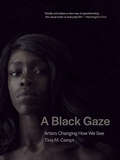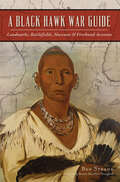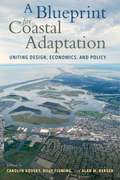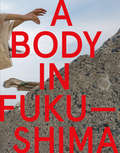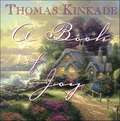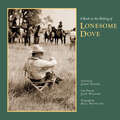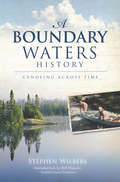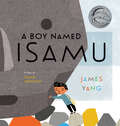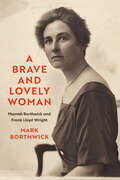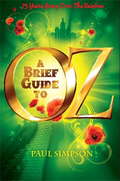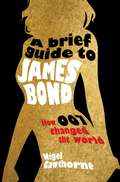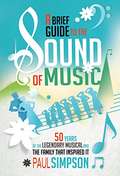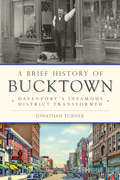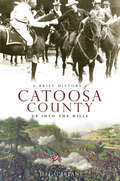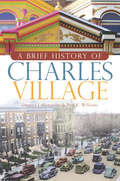- Table View
- List View
A Bit of Me: From Basildon to Broadway, and back
by Denise Van OutenDenise Van Outen, original 90s 'ladette', West End star and primetime TV favourite, reveals for the first time the true story of grit and graft beneath the famous Essex sparkle.In this refreshingly candid memoir, Denise speaks openly and sensitively about her rollercoaster career, her struggles in a past high-profile relationship and the betrayal she suffered at the hands of those once closest to her, with the hope that in doing so, she can help empower others to avoid and overcome any similar difficulties they may face.Denise shot to fame on The Big Breakfast in her early twenties. After a decade grafting through theatre jobs and children's TV shows, she was finally living the dream. However her life soon turned into a nightmare off-screen and behind the headlines as her heart was broken in a very public relationship, whilst her every move was printed in the tabloids thanks to her phone being tapped. After receiving a panning by the critics for her late night TV show aimed at the post-pub crowd, she then auditioned for and accepted an offer to play Roxie Hart in Chicago, which turned out to be a life-changing experience. The role took her to Broadway, where she caught the eye of one Andrew Lloyd Webber, eventually landing a judging role on Any Dream Will Do, which saw her rise back to primetime and the career that she loves, where she has stayed and flourished. Now, in her first memoir, Denise tells her story with disarming candour, unafraid to reveal vulnerabilities beneath the cheerful exterior. Tackling difficult subjects of corrosive self-doubt, betrayal, invasions of privacy and professional struggles, interjected with the familiar humour that we all know and love, A Bit of Me is personal, at times raw, often mischievous and always compelling. Denise has lived the life, learned the lessons, and Basildon to Broadway and back is a hell of a journey.
A Black Gaze: Artists Changing How We See
by Tina M. CamptExamining the work of contemporary Black artists who are dismantling the white gaze and demanding that we see--and see Blackness in particular--anew.In A Black Gaze, Tina Campt examines Black contemporary artists who are shifting the very nature of our interactions with the visual through their creation and curation of a distinctively Black gaze. Their work--from Deana Lawson's disarmingly intimate portraits to Arthur Jafa's videos of the everyday beauty and grit of the Black experience, from Khalil Joseph's films and Dawoud Bey's photographs to the embodied and multimedia artistic practice of Okwui Okpakwasili, Simone Leigh, and Luke Willis Thompson--requires viewers to do more than simply look; it solicits visceral responses to the visualization of Black precarity. Campt shows that this new way of seeing shifts viewers from the passive optics of looking at to the active struggle of looking with, through, and alongside the suffering--and joy--of Black life in the present. The artists whose work Campt explores challenge the fundamental disparity that defines the dominant viewing practice: the notion that Blackness is the elsewhere (or nowhere) of whiteness. These artists create images that flow, that resuscitate and revalue the historical and contemporary archive of Black life in radical ways. Writing with rigor and passion, Campt describes the creativity, ingenuity, cunning, and courage that is the modus operandi of a Black gaze.
A Black Hawk War Guide: Landmarks, Battlefields, Museums & Firsthand Accounts (Military)
by Ben StrandThe Black Hawk War was the final conflict east of the Mississippi River between American Indian communities and the United States regular troops and militia. Exploring the museums, wayside markers and parks relating to that struggle is not just a journey of historic significance through beautiful natural scenery. It is also an amazing convergence of legendary personalities, from Abraham Lincoln to Jefferson Davis. Follow the fallout of the war from the Quad Cities on the Illinois/Iowa border, through the "Trembling Lands" along the Kettle Morraine and into the Driftless Area of southern Wisconsin. Pairing local insight with big-picture perspective, Ben Strand charts an overlooked quadrant of America's frontier heritage.
A Blueprint for Coastal Adaptation: Uniting Design, Economics, and Policy
by Carolyn KouskyTens of millions of Americans are at risk from sea level rise, increased tidal flooding, and intensifying storms. The design and policy decisions that have shaped coastal areas are in desperate need of updates to help communities better adapt to a changing climate. A Blueprint for Coastal Adaptation identifies a bold new research and policy agenda and provides implementable options for coastal communities. In this book, coastal adaptation experts discuss the interrelated challenges facing communities experiencing sea level rise and increasing storm impacts. These issues extend far beyond land use planning into housing policy, financing for public infrastructure, insurance, fostering healthier coastal ecosystems, and more. Deftly addressing far-reaching problems from cleaning up contaminated, abandoned sites, to changes in drinking water composition, chapters give a clear-eyed view of how we might yet chart a course for thriving coastal communities. They offer a range of climate adaptation policies that could protect coastal communities against increasing risk, while preserving the economic value of these locations, their natural environments, and their community and cultural values. Lessons are drawn from coastal communities around the United States to present equitable solutions. The book provides tools for evaluating necessary tradeoffs to think more comprehensively about the future of our coastal communities. Coastal adaptation will not be easy, but planning for it is critical to the survival of many communities. A Blueprint for Coastal Adaptation will inspire innovative and cross-disciplinary thinking about coastal policy at the state and local level while providing actionable, realistic policy and planning options for adaptation professionals and policymakers.
A Boal Companion: Dialogues on Theatre and Cultural Politics
by Jan Cohen-Cruz Mady SchutzmanThis carefully constructed and thorough collection of theoretical engagements with Augusto Boal’s work is the first to look ’beyond Boal’ and critically assesses the Theatre of the Opressed (TO) movement in context. A Boal Companion looks at the cultural practices which inform TO and explore them within a larger frame of cultural politics and performance theory. The contributors put TO into dialogue with complexity theory – Merleau-Ponty, Emmanuel Levinas, race theory, feminist performance art, Deleuze and Guattari, and liberation psychology – to name just a few, and in doing so, the kinship between Boal’s project and multiple fields of social psychology, ethics, biology, comedy, trauma studies and political science is made visible. The ideas generated throughout A Boal Companion will: expand readers' understanding of TO as a complex, interdisciplinary, multivocal body of philosophical discourses provide a variety of lenses through which to practice and critique TO make explicit the relationship between TO and other bodies of work. This collection is ideal for TO practitioners and scholars who want to expand their knowledge, but it also provides unfamiliar readers and new students to the discipline with an excellent study resource.
A Body in Fukushima
by William Johnston Eiko OtakeOn March 11, 2011 one of the most powerful earthquakes in recorded history devastated Japan, triggering a massive tsunami and nuclear meltdowns at three reactors in the Fukushima Daiichi Nuclear Power Plant complex in a triple disaster known as 3.11. On five separate journeys, Japanese-born performer and dancer Eiko Otake and historian and photographer William Johnston visited multiple locations across Fukushima, creating 200 transformative color photographs that document the irradiated landscape, accentuated by Eiko's poses depicting both the sorrow and dignity of the land. The book also includes essays and commentary reflecting on art, disaster, and grief.From the PrefaceTHIS IS A BOOK OF FUKUSHIMA. THIS IS A BOOK OF WAILING AND UPSET, inhabiting time after March 11, 2011 and imagining time before then. This is a book of the irradiated landscape of Fukushima. This is a book of violence, and of disasters, fast and slow. This is a book of people, mountains, fields and the sea. This book is A Body in Fukushima: the body of a performer—an immigrant artist from Japan, and the body of a historian who is also a photographer, and the body of the land itself.We traveled together to Fukushima five times between 2014 and 2019. Eiko performed in the disrupted landscapes. Bill photographed the performances. Together we selected the photographs and writings for this book, and Bill wrote the captions. The year 2021 marks the tenth anniversary of the Fukushima nuclear disaster. The Timeline in the book extends to include a deeper history that is part of this tragedy and this place. And Places Visited shows the coastline where we performed and photographed. We hope that these images allow you to enter Fukushima, to feel and smell it. —EO & WJ
A Body of Work: Dancing to the Edge and Back
by David HallbergDavid Hallberg, the first American to join the famed Bolshoi Ballet as a principal dancer and the dazzling artist The New Yorker described as &“the most exciting male dancer in the western world,&” presents a look at his artistic life—up to the moment he returns to the stage after a devastating injury that almost cost him his career.Beginning with his real-life Billy Elliot childhood—an all-American story marred by intense bullying—and culminating in his hard-won comeback, Hallberg&’s &“moving and intelligent&” (Daniel Mendelsohn) memoir dives deep into life as an artist as he wrestles with ego, pushes the limits of his body, and searches for ecstatic perfection and fulfillment as one of the world&’s most acclaimed ballet dancers. Rich in detail ballet fans will adore, Hallberg presents an &“unsparing…inside look&” (The New York Times) and also reflects on universal and relatable themes like inspiration, self-doubt, and perfectionism as he takes you into daily classes, rigorous rehearsals, and triumphant performances, searching for new interpretations of ballet&’s greatest roles. He reveals the loneliness he felt as a teenager leaving America to join the Paris Opera Ballet School, the ambition he had to tame as a new member of American Ballet Theatre, and the reasons behind his headline-grabbing decision to be the first American to join the top rank of Bolshoi Ballet, tendered by the Artistic Director who would later be the victim of a vicious acid attack. Then, as Hallberg performed throughout the world at the peak of his abilities, he suffered a crippling ankle injury and botched surgery leading to an agonizing retreat from ballet and an honest reexamination of his entire life. Combining his powers of observation and memory with emotional honesty and artistic insight, Hallberg has written a great ballet memoir and an intimate portrait of an artist in all his vulnerability, passion, and wisdom. &“Candid and engrossing&” (The Washington Post), A Body of Work is a memoir &“for everyone with a heart&” (DC Metro Theater Arts).
A Book of Joy
by Thomas Kinkade"Give yourself a perk. Condition yourself for joy by doing little things that you love on a regular basis." Thomas Kinkade is America's most collected living artist. Each of the tranquil, light-infused paintings he creates is a quiet messenger, affirming the basic values of family, home, faith, and the luminous beauty of nature. Thomas Kinkade's paintings and his own words, as well as the words of Shakespeare, Keats, Wordsworth, and others, create a breathtaking gift book that is a jubilant celebration of beauty and joy. Kinkade points out that sources of joy can be found everywhere in the simple gifts life presents, such as the handshake of a friend, the caress of a warm breeze, or the sights and sounds of creation. He reminds readers that "Once you begin looking, you may be surprised to discover just how much joy your world has to offer."Copyright 2005 Thomas Kinkade, The Thomas Kinkade Company, Inc., Morgan Hill, CA
A Book on the Making of Lonesome Dove (Southwestern & Mexican Photography Series, The Wittliff Collections at Texas State University)
by Jeff Wilson John SpongA photo-filled behind-the-scenes journey into the creation of the book, the miniseries, and the world of Lonesome Dove.Widely acclaimed as the greatest Western ever made, Lonesome Dove has become a true American epic. Larry McMurtry’s Pulitzer Prize–winning novel was a New York Times bestseller, with millions of copies in print, and the miniseries has won seven Emmys.In this treasury, John Spong talks to forty of the key people involved, including author Larry McMurtry; actors Robert Duvall, Tommy Lee Jones, Anjelica Huston, Diane Lane, Danny Glover, Ricky Schroder, D. B. Sweeney, Frederic Forrest, and Chris Cooper; executive producer and screenwriter Bill Wittliff; executive producer Suzanne de Passe; and director Simon Wincer. They and a host of others tell lively stories about McMurtry’s writing of the epic novel and the process of turning it into the miniseries Lonesome Dove. Accompanying their recollections are photographs of iconic props, costumes, set designs, and shooting scripts. Rounding out the book are continuity Polaroids used during filming and photographs taken on the set by Bill Wittliff, which place you behind the scenes in the middle of the action.Designed as a companion for A Book of Photographs from Lonesome Dove, Wittliff’s magnificent fine art volume, A Book on the Making of Lonesome Dove is a must-have for every fan.
A Book to Brighten Your Day: Murphy's Sketches
by Kerri CunninghamThis is a heart-warming collection of illustrations from the much-loved viral sensation, Murphy's Sketches (@murphys_sketches) on Instagram. The perfect gem of a gift for yourself or for your loved ones - A Book to Brighten Your Day is a comforting treasury of positivity and joy. Filled with stunning drawings, life-affirming words and inspirational poems, these pages will make you pause, take a breath and appreciate the beauty in the smaller, everyday moments. It's the perfect guide as you reset at the beginning of the year, enjoy the world in bloom in spring, make the most of the summer sunshine and finally, get cosy and festive as the year ends. Featuring over two hundred beautiful, calming and entertaining illustrated pages, A Book to Brighten Your Day will help you find joy everyday, come rain or shine.
A Book to Brighten Your Day: Murphy's Sketches
by Kerri CunninghamTHE PERFECT BOOK TO BRIGHTEN YOUR YEAR! This heart-warming collection of illustrations from the much-loved viral sensation, Murphy's Sketches (@murphys_sketches) on Instagram is the most wonderful gift for yourself or for your loved ones - A Book to Brighten Your Day is a comforting treasury of positivity and joy.Filled with stunning drawings, life-affirming words and inspirational poems, these pages will make appreciate the beauty in the small, everyday moments. It'll help you reset at the beginning of the year, enjoy the world in bloom in spring, make the most of the summer sunshine and finally, get cosy and festive as the year ends. A Book to Brighten Your Day will ensure you find joy everyday, come rain or shine.
A Booze & Vinyl Christmas: Merry Music-and-Drink Pairings to Celebrate the Season
by André DarlingtonCelebrate the holidays with this merry collection of beloved Christmas albums paired with mood-setting cocktails—a companion to the bestselling listening party guide, Booze & Vinyl. Whether you're planning your finest Ugly Christmas Sweater Party or spending a quiet evening by the stocking-lined fireside at home, make the season bright with this guide to 40 favorite holiday albums from the 1940s to the present. Each entry features liner notes on the album and accompanying boozy beverage recipes that complement the music or connect the drink to the artist. Select holiday food recipes throughout complete the experience. Among the artist albums featured are: Johnny Mathis, the Beach Boys, Elvis, the Jackson 5, Mariah Carey, Bob Dylan, Justin Bieber, Gwen Stefani, Sia, Dolly Parton, Bing Crosby, Nat King Cole, Vince Guaraldi, Barbara Streisand, Willie Nelson, Boyz II Men, Celine Dion, Carrie Underwood, Frank Sinatra, Ella Fitzgerald, Dean Martin, Michael Bublé, and John Legend.
A Boundary Waters History: Canoeing Across Time (Sports History Ser.)
by Stephen Wilbers Bill HansenTeasing out the history of a place celebrated for timelessness--where countless paddle strokes have disappeared into clear waters--requires a sure and attentive hand. Stephen Wilbers's account reaches back to the glaciers that first carved out the Boundary Waters and to the original inhabitants, as well as to generations of wilderness explorers, both past and present. He does so without losing the personal relationship built through a lifetime of pilgrimages (anchored by almost three decades of trips with his father). This story captures the untold broader narrative of the region, as well as a thousand different details sure to be recognized by fellow pilgrims, like the grinding rhythm of a long portage or the loon call that slips into that last moment before sleep.
A Boy Named Isamu: A Story of Isamu Noguchi
by James YangAwarded an Asian/Pacific American Award for Literature Picture Book Honor, this stunning picture book brings to life the imagination of Japanese American artist, Isamu Noguchi.(Cover image may vary.)If you are Isamu, stones are the most special of all.How can they be so heavy?Would they float if they had no weight?Winner of the Theordor Seuss Geisel Award in 2020 for Stop! Bot!, James Yang imagines a day in the boyhood of Japanese American artist, Isamu Noguchi. Wandering through an outdoor market, through the forest, and then by the ocean, Isamu sees things through the eyes of a young artist . . .but also in a way that many children will relate. Stones look like birds. And birds look like stones. Through colorful artwork and exquisite text, Yang translates the essence of Noguchi so that we can all begin to see as an artist sees.
A Boy Named Shel: The Life and Times of Shel Silverstein
by Lisa RogakFew authors are as beloved as Shel Silverstein. His inimitable drawings and comic poems have become the bedtime staples of millions of children and their parents, but few readers know much about the man behind that wild-eyed, bearded face peering out from the backs of dust jackets.In A Boy Named Shel, Lisa Rogak tells the full story of a life as antic and adventurous as any of his creations. A man with an incurable case of wanderlust, Shel kept homes on both coasts and many places in between---and enjoyed regular stays in the Playboy Mansion. Everywhere he went he charmed neighbors, made countless friends, and romanced almost as many women with his unstoppable energy and never-ending wit. His boundless creativity brought him fame and fortune---neither of which changed his down-to-earth way of life---and his children's books sold millions of copies. But he was much more than "just" a children's writer. He collaborated with anyone who crossed his path, and found success in a wider range of genres than most artists could ever hope to master. He penned hit songs like "A Boy Named Sue" and "The Unicorn." He drew cartoons for Stars & Stripes and got his big break with Playboy. He wrote experimental plays and collaborated on scripts with David Mamet. With a seemingly unending stream of fresh ideas, he worked compulsively and enthusiastically on a wide array of projects up until his death, in 1999. Drawing on wide-ranging interviews and in-depth research, Rogak gives fans a warm, enlightening portrait of an artist whose imaginative spirit created the poems, songs, and drawings that have touched the lives of so many children---and adults.
A Brave and Lovely Woman: Mamah Borthwick and Frank Lloyd Wright
by Mark BorthwickMamah Borthwick was an energetic, intelligent, and charismatic woman who earned a master’s degree at a time when few women even attended college, translated writings by a key figure of the early feminist movement, and taught at one of Germany’s best schools for boys. She is best known, however, as the mistress of the famous American architect Frank Lloyd Wright, and for her shocking murder at the renowned Wisconsin home he built for her, Taliesin. A Brave and Lovely Woman offers an important corrective to the narrative of Wright and Borthwick, a love story as American in character as it is Shakespearean in conclusion. Little of Wright’s life and work has been left untouched by his many admirers, critics, and biographers. And yet the woman who stood at the center of his emotional life, Mamah Borthwick, has fallen into near obscurity. Mark Borthwick—a distant relative—recenters Mamah Borthwick in her own life, presenting a detailed portrait of a fascinating woman, a complicated figure who was at once a dedicated mother and a faithless spouse, a feminist and a member of a conservative sorority, a vivacious extrovert and a social pariah. Careful research and engaging prose at last give Borthwick, an obscure but crucial character in one of America’s most famous tragedies, center stage.
A Brief Atlas of Lighthouses at the End of the World
by José Luis González MacíasA unique illustrated exploration of our favorite oceanic beacons and their haunted histories.There is something beautiful and wild in the impossible architecture of lighthouses. These precariously perched structures have been the homes and workplaces of keepers whose romantic guardianship has saved countless lives from cruel seas. While that way of life may have faded away, as the lights go out and the buildings crumble, we still have their stories.This collection of more than thirty tales spans the heights and depths of human experience: the blind lighthouse keeper tending a light in the Arctic Circle, the intrepid young woman saving ships from wreck beginning at just age twelve, the desperate plight of a crew cut off for forty days with meager supplies, the lighthouse haunted by the clacking sound of a long-passed keeper’s ghostly typewriter.Interweaving literary inspiration and elements from Jules Verne, Virginia Woolf, and Edgar Allan Poe and accompanied by beautiful illustrations, nautical charts, maps, architectural plans, and curious facts, these illuminating stories will transport the reader in a book as full of wonder as the far-flung lighthouses themselves.QUIRKY STORIES AND A LITERARY APPROACH: Fascinating stories and anecdotes about each lighthouse include such features as notable inhabitants (Virginia Woolf), tantalizing on-site discoveries (Edgar Allen Poe’s unfinished writings), and weird twists, such as a never-before-seen species made extinct by a lighthouse keeper’s cat (Tibbles).UNIQUELY ILLUSTRATED: The gorgeous pointillistic full-page illustrations, equally beautiful location maps, and detailed building diagrams make this a distinctive celebration of these fascinating structures and their places in the world.AN ARMCHAIR TOUR OF LIGHTHOUSES AROUND THE WORLD: The thirty+ stunning lighthouses featured include:Adziogol Lighthouse: Rybalche, Kherson Oblast (Ukraine)Amédée Lighthouse: Amédée, Nouméa, New Caledonia (France)Bell Rock Lighthouse: Inchcape Rock, Arbroath, Scotland (UK)Buda Lighthouse: Buda Island, San Jaime de Enveija, Tarragona (Spain)Eddystone Lighthouse: Eddystone Rocks, Rame Head, Plymouth (UK)Evangelistas Lighthouse: Evangelistas Islets, Natales, Última Esperanza (Chile)Great Isaac Cay Lighthouse: Great Isaac Cay, Bimini Islands (Bahamas)Grip Lighthouse: Grip, Kristiansund, Nordmøre, Møre og Romsdal (Norway)Guardafui Lighthouse: Cape Guardafui, Bari, Puntland (Somalia)Klein Curaçao Lighthouse: Klein Curaçao, Curaçao (Netherlands)Lime Rock Lighthouse: Lime Rock, Newport, Rhode Island (USA)Maatsuyker Lighthouse: Maatsuyker Island, Tasmania (Australia)Robben Island Lighthouse: Robben Island, Cape Town (South Africa)Rocher aux Oiseaux Lighthouse: Rocher aux Oiseaux (Bird Rock), Madeleine Islands, Quebec (Canada)Rubjerg Knude Lighthouse: Rubjerg, Hjørring, Jutland (Denmark)San Juan de Salvamento Lighthouse: Isla de los Estados, Patagonia (Argentina)Smalls Lighthouse: Smalls Rocks, Marloes, Pembrokeshire, Wales (UK)Stephens Island Lighthouse: Takapourewa or Stephens Island, Marlborough (New Zealand)Svyatonossky Lighthouse: Svyatoy Nos, Múrmansk Oblast (Russia)Wenwei Zhou Lighthouse: Wenwei Zhou or Gap Rock, Wanshan Archipelago, Hong Kong (China)Perfect for:Readers of quirky historyFans of nautical talesCoastal residents and visitorsArmchair travelersAnyone who has ever dreamed of life as a lighthouse keeperGift giving for Father's Day, Mother's Day, birthday, graduation, or housewarming
A Brief Guide To OZ: 75 Years Going Over The Rainbow (Brief Histories)
by Paul SimpsonWhat if Dorothy Gale wasn't the only person who went to see the Wizard of Oz? MGM's landmark 1939 movie The Wizard of Oz, starring Judy Garland, did not mark the beginning of adventures in Oz. Both before and since, dozens of tales have been told of the Marvellous Land of Oz, and its inhabitants such as the Scarecrow, the Tin Woodman, the Cowardly Lion, the Hungry Tiger and Jack Pumpkinhead. In this fascinating and wide-ranging book, Paul Simpson looks back at the Famous Forty - the original novels by L. Frank Baum and his successors which entranced generations of children with their wonderful world of munchkins, princesses and wicked witches. He examines the many ways in which the stories have been retold in movies - from the silent era to Disney's recent blockbuster Oz the Great and Powerful - and on television, featuring everyone from Tom & Jerry to trades union leaders. On stage, Oz has come to life in the many revivals of The Wizard of Oz musical and the worldwide reign of Elphaba in the smash hit Wicked. Celebrate the 75th anniversary of the world's best-loved film and the whole magical world of Oz with its vampires, muppets, dragons, living statues and so much more.
A Brief Guide To OZ: 75 Years Going Over The Rainbow
by Paul SimpsonWhat if Dorothy Gale wasn't the only person who went to see the Wizard of Oz? MGM's landmark 1939 movie The Wizard of Oz, starring Judy Garland, did not mark the beginning of adventures in Oz. Both before and since, dozens of tales have been told of the Marvellous Land of Oz, and its inhabitants such as the Scarecrow, the Tin Woodman, the Cowardly Lion, the Hungry Tiger and Jack Pumpkinhead. In this fascinating and wide-ranging book, Paul Simpson looks back at the Famous Forty - the original novels by L. Frank Baum and his successors which entranced generations of children with their wonderful world of munchkins, princesses and wicked witches. He examines the many ways in which the stories have been retold in movies - from the silent era to Disney's recent blockbuster Oz the Great and Powerful - and on television, featuring everyone from Tom & Jerry to trades union leaders. On stage, Oz has come to life in the many revivals of The Wizard of Oz musical and the worldwide reign of Elphaba in the smash hit Wicked. Celebrate the 75th anniversary of the world's best-loved film and the whole magical world of Oz with its vampires, muppets, dragons, living statues and so much more.
A Brief Guide to James Bond
by Nigel CawthorneThe world's fascination with Bond is unstoppable. James Bond is the greatest British fictional hero of the post-war era. He also has a huge following in the US - and around the world - as a legendary Cold War warrior, and now as a daredevil able to take on the villains of the post-Cold War world. The Bond books are all in print. Today, Sebastian Faulks is writing new stories while Charlie Higson is writing children's versions.In this comprehensive guide to Ian Fleming, the books, the films and the world that was created out of 007, Nigel Cawthorne uncovers Bond's allure. It comes with special sections on the main characters - Q, M, the Bond Girls, and the women who first inspired them; the cars, and the incomparable baddies. It will be the ideal gift for fans and aficionados alike and will be published to coincide with the 50th anniversary of DOCTOR NO; the new film is scheduled for autumn 2012.
A Brief Guide to The Sound of Music: 50 Years of the Legendary Musical and the Family who Inspired It (Brief Histories Ser.)
by Paul SimpsonEveryone has heard the songs from The Sound of Music by Rodgers and Hammerstein. The stage show was a roaring success in New York and London, and the much-loved feature film, directed by Hollywood veteran Robert Wise, continues to be a staple of television schedules 50 years after its release in 1965. In this fascinating and wide-ranging book, Paul Simpson explores the incredible story of the Von Trapp family and their escape from the Third Reich in all its incarnations, from real-life adventure, to book, to stage, to award-winning film to cultural phenomenon. He discusses the stage show, the many differences that were incorporated into the fictionalisation of the tale, and how that story was brought to the screen. He also looks at the numerous other ways in which the Von Trapp?s story has been told, including the two West German movies from the 1950s and the extensive forty-part Japanese anime series from the 1990s, to explain why the story of the Von Trapp family has appealed to so many generations.Praise for A Brief Guide to Stephen King:'The best book about King and his work I have ever read' Books Monthly
A Brief Guide to The Sound of Music: 50 Years of the Legendary Musical and the Family who Inspired It (Brief Histories)
by Paul SimpsonEveryone has heard the songs from The Sound of Music by Rodgers and Hammerstein. The stage show was a roaring success in New York and London, and the much-loved feature film, directed by Hollywood veteran Robert Wise, continues to be a staple of television schedules 50 years after its release in 1965. In this fascinating and wide-ranging book, Paul Simpson explores the incredible story of the Von Trapp family and their escape from the Third Reich in all its incarnations, from real-life adventure, to book, to stage, to award-winning film to cultural phenomenon. He discusses the stage show, the many differences that were incorporated into the fictionalisation of the tale, and how that story was brought to the screen. He also looks at the numerous other ways in which the Von Trapp’s story has been told, including the two West German movies from the 1950s and the extensive forty-part Japanese anime series from the 1990s, to explain why the story of the Von Trapp family has appealed to so many generations.Praise for A Brief Guide to Stephen King:'The best book about King and his work I have ever read' Books Monthly
A Brief History of Bucktown: Davenport's Infamous District Transformed (Brief History)
by Jonathan TurnerGerman immigrants created leafy beer gardens here nearly two centuries ago, establishing Bucktown as the heart of entertainment in downtown Davenport for generations. In 1916, the founding of the Tri-City Symphony Orchestra at the Burtis Opera House embodied the neighborhood's reputation for high culture. The numerous saloons and theaters, as well as the forty-two documented brothels that flourished within two blocks, lent a bawdy side to the good times. Varied industries thrived through World War II, and downtown bustled with shoppers visiting department stores like Petersen's. Later, the neighborhood struggled and declined as a farming crisis hit the region hard. With revitalized landmarks like the magnificent Hotel Blackhawk and the historic Redstone Building, the community is growing more vibrant as a place to live, work and play. Author Jonathan Turner explores this dynamic history and transformation.
A Brief History of Catoosa County: Up Into the Hills (Brief History)
by Jeff O'BryantCatoosa County's rich history touches upon many of thedefining events and social changes of America's past. As settlers expanded westward, Georgia forcibly removed Native Americans from the boundaries of what would eventually form Catoosa, a Cherokee name that the settlers adopted as their own. As the site of the second most costly battle in the Civil War, Chickamauga set the stage for much that followedin Catoosa's history, from the end of a three-thousand-year-old mode of warfare to the beginnings of women's service in the military. Though nearly one million people visit Chickamauga and Chattanooga National Military Park each year seeking to understand and connect to the Civil War struggle, many remain unaware of the larger part Catoosa played in the unfolding drama of America. Join local historian Jeff O'Bryant as he brings this valuable heritage to light.
A Brief History of Charles Village
by Paul K. Williams Gregory J. AlexanderBaltimore Orioles, infamous bootleggers, novelists of the Jazz Age and famous musicians have all wandered and lived among the stately Victorian homes and vibrant "painted ladies" of Charles Village. From its beginning as a series of country villas for the wealthy elite of Baltimore to escape the crush of downtown, the neighborhood has become a diverse and vibrant cultural hub of the city. Local authors Gregory J. Alexander and Paul K. Williams chart the evolution of this famous Baltimore community and its institutions while telling fascinating tales of some of its most colorful residents.

